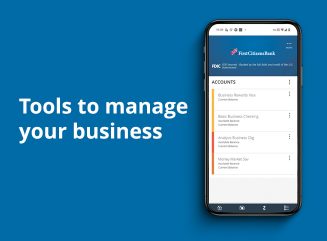
Digital banking for business
Seamlessly access all of your accounts from one place with First Citizens Digital Banking for business.
Investment always involves some level of risk—how much you're willing to take on depends on your goals, your responsibilities and your general outlook on your financial life.

Low-risk investments can provide stable returns and may be the most suitable option for your circumstances and your personality. If you're interested in a secure way to invest money and see steady growth, you'll likely want to look for safe, consistent investment strategies.
There are several reasons why you might favor low-risk investments over higher-risk opportunities.
If you've never invested before, you may not be comfortable with different types of investments. You may feel more at ease with greater stability so you're not worried about losing money and don't feel out of your depth. Starting with lower-risk investments can help you achieve small wins and feel more confident about taking risks in the future.
The closer you get to retirement, the less time you have to wait for a high-risk investment to pay off. Knowing that you'll need the money to live on once you leave the workforce, you're likely to prefer more predictable returns so you know the funds will be available when you need them.
If you don't have much investment capital, you may prefer smart, safe moves. Although high-risks can give you significant returns, they do come with a greater likelihood of losing some money on a volatile stock or company. You can always start with a more traditional investment and then use a portion of your earnings to expand your risk portfolio. That way, you're building your nest egg without closing yourself off to potentially high-return investments.
Some people simply don't like risk-taking. The market can be volatile, and it may be tough to wait out a downturn if you're scrutinizing your day-to-day losses. Ideally, your portfolio will include a mix of low- and high-risk investments to maximize your earnings. But if you really can't stomach the market swings, a good investment advisor can help you build a strategy that won't keep you up at night.
There are a number of low-risk investments you can add to your portfolio, and you'll want to work with your financial advisor or investment firm to decide which make sense for your goals. Here are some common options.
A high-yield savings account allows you to earn interest on your savings, and you can also easily withdraw money if you need access to cash. However, the sooner you withdraw the money, the less interest you'll have accrued, giving you less benefit than other investments.
Similar to high-yield savings accounts, certificates of deposit, or CDs, allow you to earn interest on your money. Usually, you agree to put your money in a CD for specific period of time, and you'll pay a penalty if you withdraw it early. CDs are fairly low-risk, but they often pay higher interest rates than high-yield savings accounts.
These investments are backed by the government, adding an element of security you won't find with other investments. You earn interest on the bonds and can redeem their full value if you own them until they mature.
Not all mutual funds are inherently low-risk, but because funds include a mix of investment assets, there may be some options for you. Your investment advisor can help you choose a mutual fund that contains mostly lower-risk investments.
As with treasury bonds, you get back your principal investment plus interest, assuming you hold the bonds for an agreed-upon period of time. If you're risk-averse, you'll want to buy bonds from companies with proven track records of stability and profitability.
Once you start looking at low-risk investments, you'll find there are a broad range of options for generating new income. You can go it alone and build your own strategy or hire an advisor who can help you choose your investments based on your short- and long-term goals. Whichever approach you choose, it's important to trust your instincts on how much risk you can tolerate.
Email Us
Please select the option that best matches your needs.
Customers with account-related questions who aren't enrolled in Digital Banking or who would prefer to talk with someone can call us directly.